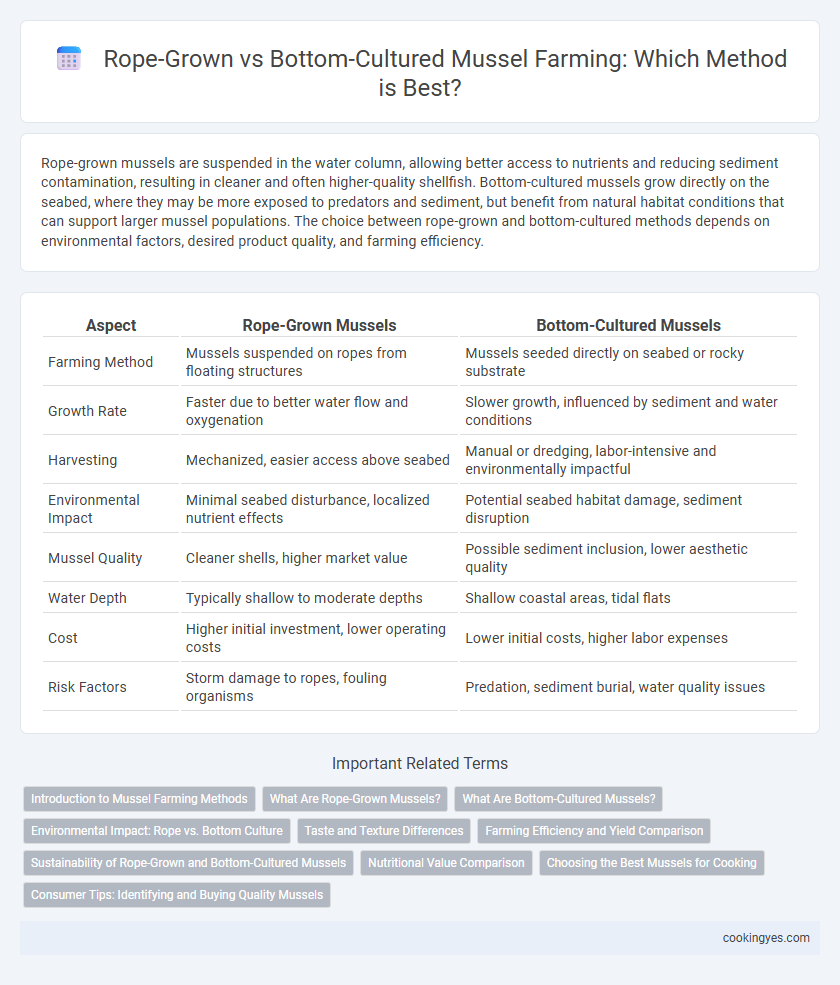Rope-grown mussels are suspended in the water column, allowing better access to nutrients and reducing sediment contamination, resulting in cleaner and often higher-quality shellfish. Bottom-cultured mussels grow directly on the seabed, where they may be more exposed to predators and sediment, but benefit from natural habitat conditions that can support larger mussel populations. The choice between rope-grown and bottom-cultured methods depends on environmental factors, desired product quality, and farming efficiency.
Table of Comparison
| Aspect | Rope-Grown Mussels | Bottom-Cultured Mussels |
|---|---|---|
| Farming Method | Mussels suspended on ropes from floating structures | Mussels seeded directly on seabed or rocky substrate |
| Growth Rate | Faster due to better water flow and oxygenation | Slower growth, influenced by sediment and water conditions |
| Harvesting | Mechanized, easier access above seabed | Manual or dredging, labor-intensive and environmentally impactful |
| Environmental Impact | Minimal seabed disturbance, localized nutrient effects | Potential seabed habitat damage, sediment disruption |
| Mussel Quality | Cleaner shells, higher market value | Possible sediment inclusion, lower aesthetic quality |
| Water Depth | Typically shallow to moderate depths | Shallow coastal areas, tidal flats |
| Cost | Higher initial investment, lower operating costs | Lower initial costs, higher labor expenses |
| Risk Factors | Storm damage to ropes, fouling organisms | Predation, sediment burial, water quality issues |
Introduction to Mussel Farming Methods
Rope-grown mussel farming involves suspending mussels on ropes anchored in the water column, promoting cleaner growth and reducing sediment contact, which enhances shell quality. Bottom-cultured mussels are cultivated directly on the seabed, leveraging natural substrates but increasing exposure to predators and sediment-related issues. Both methods optimize production based on environmental conditions, water flow, and local ecosystem characteristics.
What Are Rope-Grown Mussels?
Rope-grown mussels are cultivated by suspending ropes vertically in nutrient-rich waters, allowing mussels to attach and grow in a suspended environment. This method promotes faster growth, improved water flow, and cleaner shells compared to bottom-cultured mussels, which grow directly on seabeds. Rope-grown mussels benefit from better water quality and reduced sediment contamination, enhancing their flavor and market value.
What Are Bottom-Cultured Mussels?
Bottom-cultured mussels are farmed directly on the seabed, where adult mussels grow naturally attached to substrates like rocks and shells. This method mimics wild conditions, resulting in mussels with a firmer texture and a more intense flavor due to their interaction with natural sediments and varying water currents. Compared to rope-grown mussels, bottom-cultured ones often require less maintenance but are more susceptible to predators and environmental fluctuations.
Environmental Impact: Rope vs. Bottom Culture
Rope-grown mussels have a lower environmental impact compared to bottom-cultured methods, as they reduce seabed disturbance and sediment resuspension, preserving benthic habitats. This suspended cultivation technique minimizes nutrient loading and limits waste accumulation, promoting better water quality and biodiversity. In contrast, bottom-cultured mussels can cause habitat degradation and altered sediment chemistry, leading to localized ecological imbalances.
Taste and Texture Differences
Rope-grown mussels generally exhibit a sweeter, cleaner taste and a plumper, juicier texture due to their suspended growth in nutrient-rich waters, allowing better filtration and less sediment exposure. Bottom-cultured mussels often have a brinier flavor with a firmer, chewier texture resulting from contact with seabed sediments and varying water conditions. These differences impact culinary preferences, as rope-grown mussels are favored for delicate dishes, while bottom-cultured mussels suit recipes requiring robust texture.
Farming Efficiency and Yield Comparison
Rope-grown mussels demonstrate higher farming efficiency by offering better water flow and fewer sediment issues, resulting in faster growth rates compared to bottom-cultured methods. Yield comparison indicates that rope-grown techniques typically produce denser, cleaner shells with less predation, increasing overall harvest quality and market value. Bottom-cultured mussels, while less costly to set up, often suffer from hypoxia and siltation, which can reduce survival rates and lower long-term productivity.
Sustainability of Rope-Grown and Bottom-Cultured Mussels
Rope-grown mussels demonstrate superior sustainability by minimizing seabed disturbance and allowing for higher water exchange, which reduces waste accumulation and promotes healthier ecosystems. Bottom-cultured mussels, while traditional, can negatively impact benthic habitats through sediment compaction and localized nutrient loading. Sustainable mussel farming increasingly favors rope-grown methods for their lower environmental footprint and greater potential for scalable, eco-friendly production.
Nutritional Value Comparison
Rope-grown mussels exhibit higher protein content and greater levels of omega-3 fatty acids compared to bottom-cultured mussels, attributed to their exposure to cleaner water and enhanced nutrient availability. Bottom-cultured mussels often accumulate more sediments and trace metals, which can affect their overall mineral profile and sensory qualities. Nutritional analysis consistently shows rope-grown mussels as a superior source of essential nutrients, particularly in terms of vitamin B12 and iron concentrations.
Choosing the Best Mussels for Cooking
Rope-grown mussels typically offer cleaner, juicier meat with a sweeter flavor due to their suspended growth in nutrient-rich waters, making them ideal for gourmet cooking. Bottom-cultured mussels often have earthier tastes and a firmer texture, suitable for rustic dishes that benefit from their robust flavor profile. Selecting mussels based on farming method ensures optimal texture and taste for specific culinary preparations, enhancing overall dish quality.
Consumer Tips: Identifying and Buying Quality Mussels
When selecting mussels, consumers should prioritize rope-grown mussels for their cleaner shells and reduced sediment compared to bottom-cultured varieties, which often contain grit due to seabed contact. Rope-grown mussels typically have a sweeter flavor profile and are less prone to sandiness, enhancing culinary quality. Inspect mussels for tightly closed shells and a fresh, briny aroma regardless of cultivation method to ensure freshness and safety.
Rope-grown vs bottom-cultured for mussel farming Infographic

 cookingyes.com
cookingyes.com